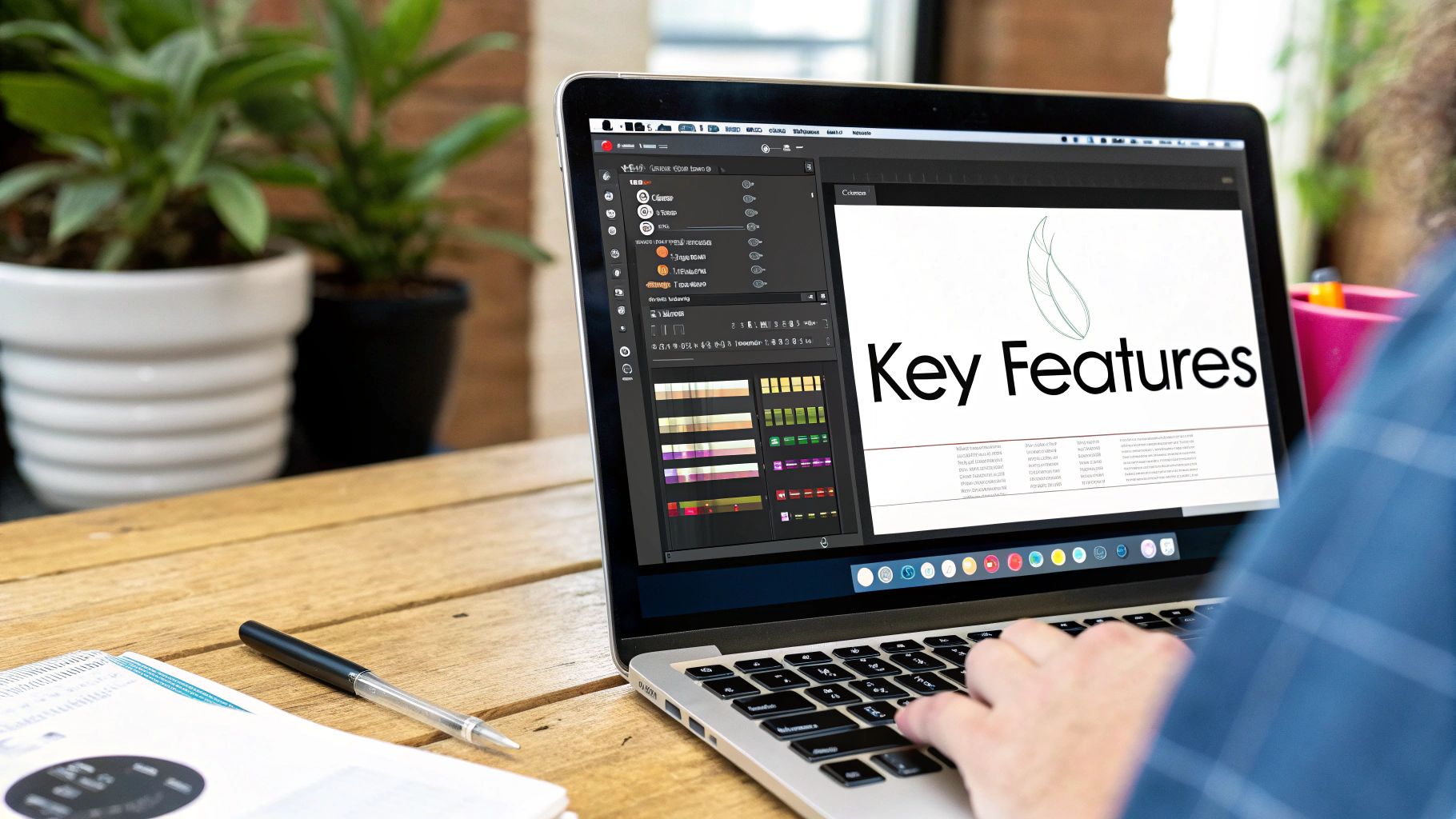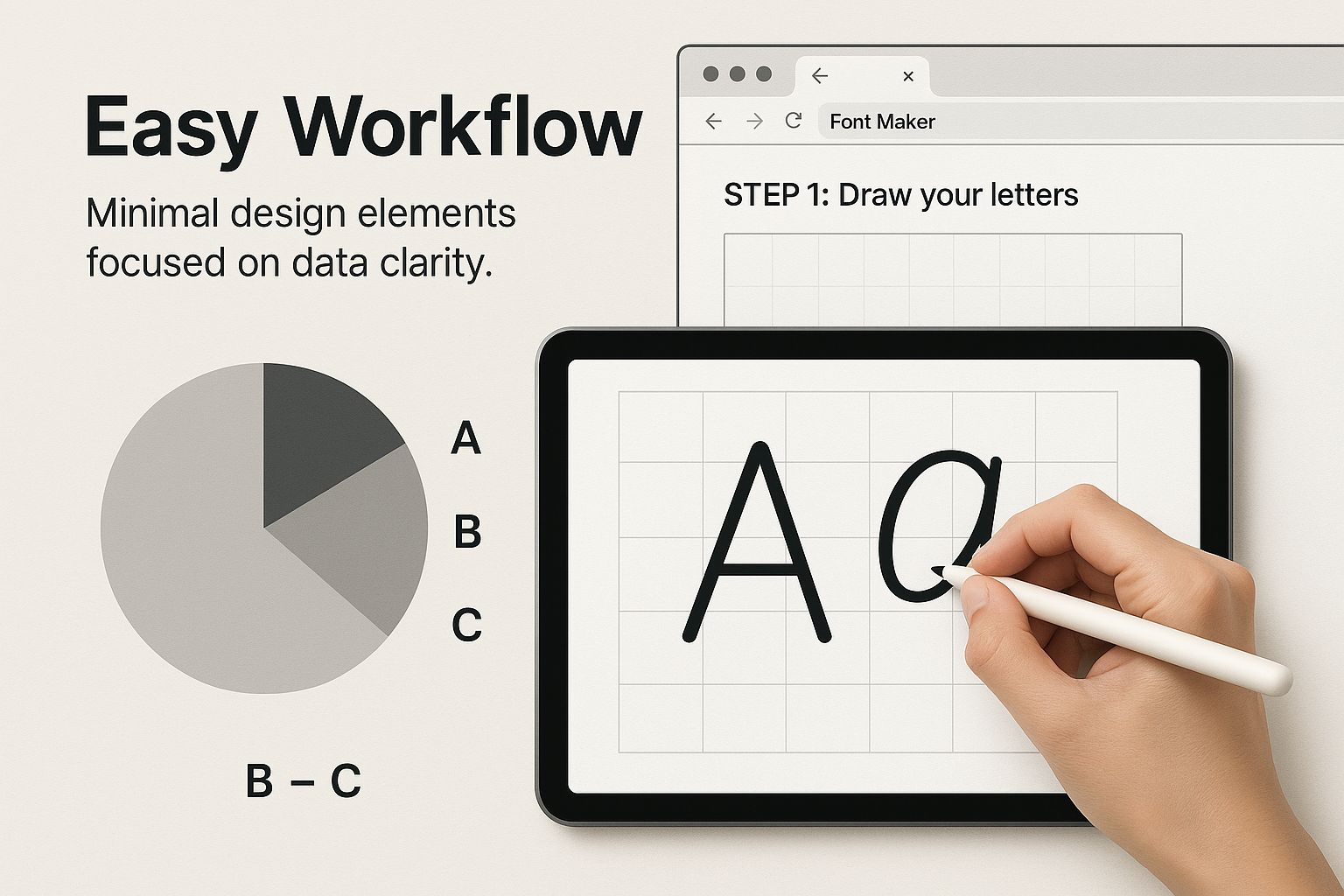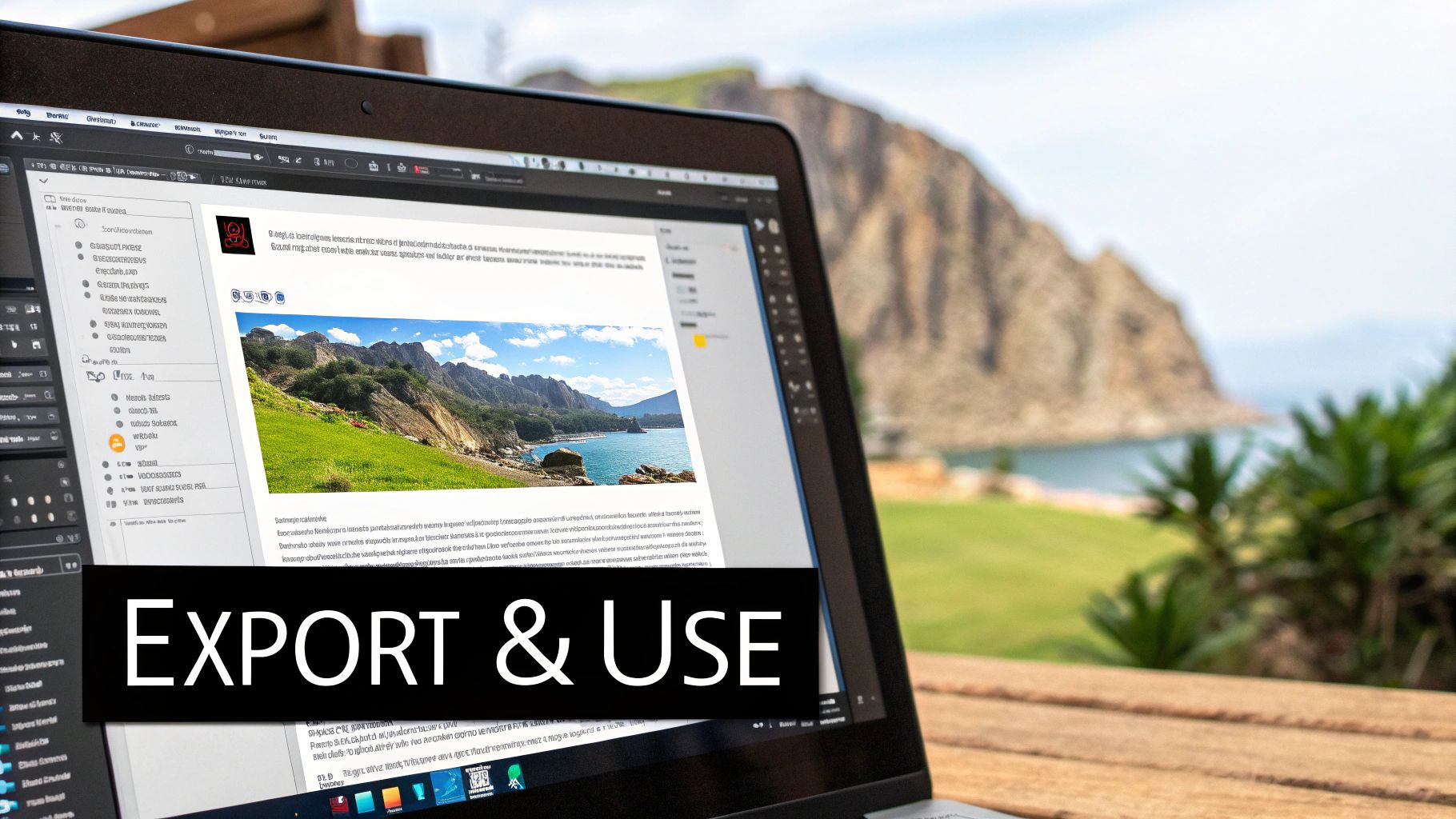Tired of scrolling through the same old typeface options for every new project? A free online font maker is your ticket to breaking free from the mould, letting you craft a completely unique font for your brand or passion project in just minutes. These tools can be anything from simple editors for tweaking existing styles to seriously clever AI font generators that build a whole new typeface from the ground up.
Why Custom Fonts Are a Creative Game-Changer

In a world buzzing with content, standing out is non-negotiable. We all know logos and colour schemes are vital, but typography is the unsung hero of brand identity. It’s the voice of your brand, setting the personality, professionalism, and tone before anyone even reads a word.
Playing it safe with a generic font like Times New Roman or Arial is fine, but it doesn't tell a story. It’s like showing up to a vibrant party in a plain uniform. Creating your own font ensures your brand's visual language is 100% yours.
The Shift to Accessible Design Tools
Not too long ago, font creation was this complex, expensive world reserved for seasoned typographers. Now, a new wave of accessible online tools has completely changed the game. Many creatives are ditching costly font licenses and embracing these flexible digital solutions, from a simple editor to a powerful AI font generator.
This isn't just a hunch; the trend is clear. In the UK, for instance, over 35% of freelance designers and small business owners are now using a free online font maker for client work. The user-friendly vibe of these platforms has sparked a huge 20% annual growth in font-related downloads.
A custom font transforms your brand from just another business into a memorable experience. It’s a subtle yet powerful tool that builds recognition and trust with your audience.
Unleashing Your Creative Potential
So, what does this actually mean for you? It means you have the freedom to design a font that perfectly captures your vision, whether it’s for a quirky art project or a sophisticated corporate identity. An AI font generator can even brainstorm ideas with you from a simple text prompt. If you want to see this in action, exploring different fonts for art is a great way to get inspired.
Here’s how it can level up your work:
- Brand Consistency: Lock in a cohesive visual identity across everything you do, from your website to your social media posts.
- Unique Personality: Develop a font that truly reflects your brand’s values—whether that's playful, elegant, modern, or traditional.
- Creative Freedom: Experiment and play around without the financial sting of buying expensive font licences.
How to Choose the Right Free Font Maker
Picking the perfect free online font maker can feel a bit like searching for a needle in a haystack. There are so many options out there, all promising to unleash your creativity. The secret? It’s all about matching the tool to your specific project and, just as importantly, your own skill level.
Some tools are beautifully simple, built around templates that are perfect for beginners who just want to make a few quick tweaks. Others are seriously powerful vector-drawing platforms that give you fine-tuned control over every curve and line—ideal if you're digitising your own handwriting or building a typeface from the ground up.
Then you have the exciting new wave of AI font generators. These tools can spit out entire font families from a simple text prompt, which is a fantastic way to brainstorm ideas or generate something totally unique with almost no effort. Your choice really depends on what you’re trying to create.
Define Your Project Needs
Before you even start looking at tools, it’s worth asking yourself a few key questions. Are you just trying to create a quick, stylish font for a social media post? Or are you diving into a full branding project that needs a robust font family with multiple weights? The answer will point you in the right direction.
A clear workflow is everything, as this infographic shows. Knowing your process helps you pick the right tool for the job.

As you start exploring, keep these factors in mind when sizing up a free online font maker:
- User Interface: Does the platform feel intuitive and easy to navigate for someone with your experience, or does it assume you’re a seasoned pro?
- Creative Capabilities: What’s under the hood? Does it support vector drawing, template customisation, AI generation, or a mix of all three?
- Export Formats: This one is crucial. Can you export your creation in essential formats like OTF (OpenType) for design software or WOFF (Web Open Font Format) for websites?
Choosing the right tool isn’t about finding the one with the most features. It's about finding the one with the right features for you and your creative vision.
To give you a clearer picture, here’s a quick comparison of the different types of free font makers you’ll likely encounter.
Feature Comparison of Free Online Font Maker Types
This table breaks down the main types of tools to help you decide which one best fits your project and comfort level.
| Tool Type |
Best For |
Key Features |
Skill Level |
| Template-Based |
Quick customisations for social media, personal projects, or beginners. |
Pre-designed templates, simple sliders for adjustments (weight, spacing), limited character sets. |
Beginner |
| Vector Drawing |
Creating unique fonts from scratch, digitising handwriting, professional typography. |
Full Bézier curve control, layer support, advanced kerning tools, glyph editing. |
Intermediate to Advanced |
| AI Generator |
Brainstorming concepts, generating unique styles quickly, exploring new ideas. |
Text-prompt-based generation, style fusion, rapid iteration, visual previews. |
Beginner to Intermediate |
Ultimately, the goal is to find a platform that feels like a natural extension of your creative process.
As you explore, you'll notice many of these font makers are web-based, which is great for accessibility. If you want to get a better handle on how different software models can impact your workflow, it’s helpful to understand the differences between desktop and web applications. This will help you choose a platform that slots perfectly into how you like to work.
Taking Your First Steps in Font Design

Jumping into font design is a blast, and thanks to a free online font maker, it’s never been easier to get started. Don't worry about being an artistic genius right out of the gate. The first few moments are all about setting up your digital canvas properly. Think of it like a chef organising their ingredients before cooking—a little prep work now saves a world of pain later.
Your first job is to get comfortable with the interface. Most tools will show you a grid where each little square, or glyph slot, is a space for a character (like A, b, ?, or 5). This is your playground for drawing each letterform. But before you dive in, there are a few core ideas you need to nail down to give your font a solid structure.
Getting Your Font Metrics Right
Every good font is built on a foundation of invisible lines called metrics. These guidelines are the secret sauce that makes all your characters look like they belong together. Getting these sorted from the very beginning is the difference between an amateur-looking font and a professional one.
Here are the key metrics you’ll need to set:
- Baseline: This is the ground floor. It’s the line most of your letters will sit on, anchoring the entire character set.
- Cap Height: As the name suggests, this line marks the top of your capital letters, like ‘H’ or ‘J’.
- X-Height: This one defines the height of your lowercase letters that don’t have bits sticking up, like ‘x’, ‘a’, and ‘c’. The relationship between the cap height and x-height has a massive impact on how readable your font is.
- Ascender and Descender Lines: The ascender line marks the top point of letters like ‘b’ and ‘d’, while the descender line catches the bottom of letters like ‘p’ and ‘g’.
Setting these values consistently makes your font feel balanced and cohesive. A good starting point is to aim for a look you like. For example, a large x-height often gives a font a modern feel that’s super legible on screens.
Pro Tip: Don’t try to design the whole alphabet in one go. You’ll burn out. Start with a few key "control characters" like 'n', 'o', 'H', and 'V'. These letters contain all the basic shapes—straight stems, perfect curves, sharp diagonals—that you can copy and tweak for the rest of your glyphs.
Drawing Your First Characters
With your metrics locked in, it’s time for the fun part: drawing. Most vector tools use something called bézier curves, which are just lines shaped by anchor points and control handles. It sounds a bit technical, but it’s actually pretty intuitive once you play around with it. Imagine bending a piece of wire—the anchor points are where you’re holding it, and the handles control the curve.
Let's take a simple sans-serif 'o' for example. You’d create an outer circle and an inner one. That negative space in the middle, the counter, is just as important as the stroke itself. You'll want the thickness of that stroke to look consistent all the way around. Here's a little secret: a vertical stroke that's 100 units thick can look visually different from a horizontal one of the same thickness. To compensate for this optical illusion, designers often make the horizontal strokes a tiny bit thinner—maybe 95 units—to achieve perfect visual balance.
This is where an AI font generator can be an absolute lifesaver. It can spit out initial letterforms based on your ideas, giving you a solid starting point that you can then manually refine. It’s the perfect blend of automation’s speed and your own creative touch, making it a powerful way to kickstart the whole process.
Exploring the Power of AI Font Generators
Welcome to the new frontier of typography, where your ideas can become fully realised fonts in the blink of an eye. An AI font generator uses sophisticated machine learning to interpret your creative vision and transform it into a unique typeface. This isn't just about tweaking pre-made templates; it’s about genuine, from-the-ground-up creation.
These tools are surprisingly versatile. You could start with a simple text prompt, something like, "create a font that feels like a 1920s jazz club poster," and watch as the AI spits out multiple design options. Or, you could upload a reference image—even a quick sketch on a napkin—and the system will analyse its style to build out an entire character set.
From Prompt to Prototype Instantly
The single biggest win of using an AI-powered free online font maker is the incredible speed. Think rapid prototyping on steroids. Instead of spending hours meticulously drawing each character just to test an idea, designers can now generate a working concept in seconds. This opens up a world of creative exploration right at the start of a project.
This technology represents a fundamental shift in the design workflow. It moves font creation from a purely manual craft to a collaborative process between human creativity and machine intelligence, opening doors to styles we haven't even imagined yet.
The integration of AI is already making serious waves. In the UK, the adoption of AI-assisted font tools among freelance designers has shot up by 25% annually since 2023. This trend is happening alongside another key technology that's making modern fonts so incredibly versatile. You can find more insights on the rise of AI in typography from WebDesignAwards.io.
Pushing Creative Boundaries with Variable Fonts
Many AI tools are now built with variable font technology, which is an absolute game-changer for digital design. A variable font isn't like a traditional font family; it's a single file that behaves like multiple fonts, letting you dynamically adjust its weight, width, and slant on the fly.
This means you can fine-tune your typography for any context without juggling dozens of separate font files. It’s no surprise that around 40% of UK graphic design professionals now use free fonts that include this dynamic capability. By combining AI generation with variable font exports, you can create a truly adaptive and unique typeface that's perfectly suited for modern web and app design.
Getting Your Custom Font Out into the World
You've spent the time crafting the perfect typeface in a free online font maker, and now it's ready for its debut. The final hurdle is exporting your creation, and this is where a little know-how goes a long way. Picking the right file format is the key to making sure your font looks just as good on a client's website as it does on your design software.
Most tools, especially an AI font generator, will offer you a few different file types. Don't just click the first one you see! Each format is designed for a specific job, and understanding them is what separates the pros from the amateurs.
Which Font Format Do You Need?
The format you choose really comes down to where you plan on using your font. While the list of file types can seem endless, you'll probably only ever need to worry about three main ones.
- OTF (OpenType Font): This is the designer's best friend. If you're working in creative software like Adobe Illustrator or Affinity Designer, OTF is your go-to. It supports all the fancy typographic extras and gives you the most professional result.
- TTF (TrueType Font): An oldie but a goodie. TTF is the workhorse of the font world, offering incredible compatibility across almost every system you can think of, including good ol' Microsoft Word.
- WOFF/WOFF2 (Web Open Font Format): As the name suggests, these are built for the web. They’re compressed to keep file sizes tiny, which means your website will load lightning-fast without your beautiful font looking blurry.
Here's a simple rule of thumb: OTF for serious design work, TTF for everyday desktop stuff, and WOFF for anything that will live online. Stick to that, and you can't go wrong.
Once you’ve exported the file, you just need to install it. We have a straightforward guide on how to install new fonts on your Windows PC that makes the process a breeze. After that, your creation will pop up in the font menu of all your favourite apps.
And if you’re planning on bringing your designs into the physical world, it’s worth learning how to use transfer paper for flawless prints to get your new font looking sharp on any surface.
Got Questions About Online Font Makers?
Diving into the world of custom typography for the first time usually sparks a few questions. It’s totally normal. From figuring out file formats to understanding who actually owns the final design, getting the basics down makes the whole process a lot smoother. Let's clear up some of the most common queries people have when they start using a free online font maker.
One of the first things designers ask is about ownership. Good question. If you create a font from the ground up using an online tool, you generally own the rights to it. That means you get to call the shots on how it’s used, whether it's for a personal blog or a major commercial campaign.
That said, it’s always smart to have a quick look at the platform's terms of service. Some tools might have specific rules, especially if your design is heavily based on one of their existing templates.
Understanding Your Creative Rights
When you're designing a font that’ll be used professionally, making sure you have full, unrestricted commercial rights is non-negotiable. This is what protects you—and your clients—from any legal snags down the road.
The rule of thumb is pretty simple: if your creation is 100% original, you’re the creator and the owner. But if you're building on someone else's foundation, like a template, the lines can get a little blurry. Always read the fine print.
For a really deep dive on this, our guide on font licensing for commercial use breaks down everything you need to know to use your custom fonts with complete confidence.
Do I Need to Be an Artist to Do This?
Not at all. Seriously. While having some drawing skills is a nice bonus if you're sketching out letterforms from scratch, most modern tools are built for everyone, regardless of artistic talent.
An AI font generator, for example, can produce incredible typefaces from just a few descriptive words. No drawing required. Other platforms can turn your own handwriting into a digital font or give you easy-to-use templates to get started. The trick is to find a free online font maker that fits your comfort level and what you’re trying to achieve with your project.
Ready to bring your unique typographic vision to life? The AI Font Generator offers over 1,400 styles and an intuitive platform to create stunning fonts in seconds, completely free. Start designing now.